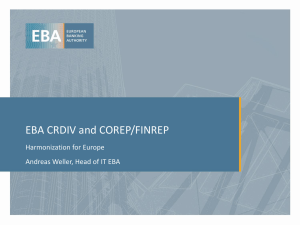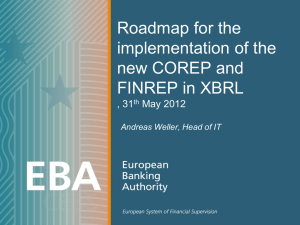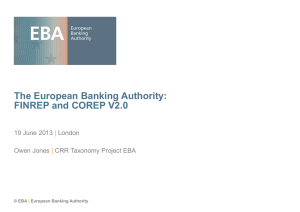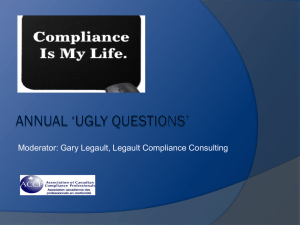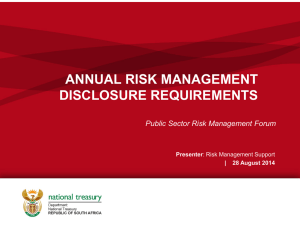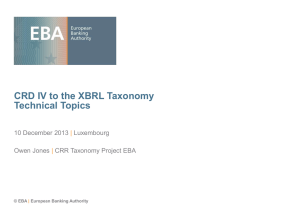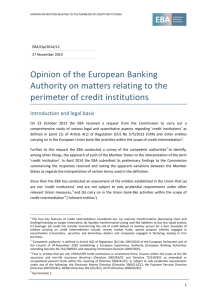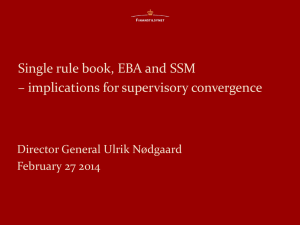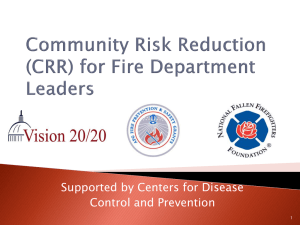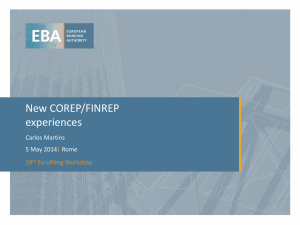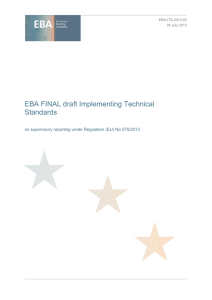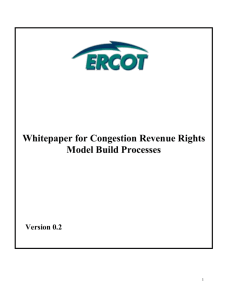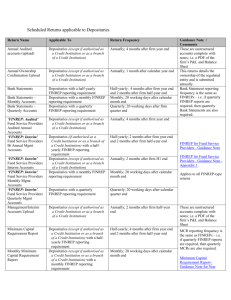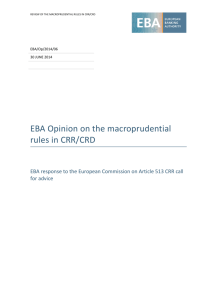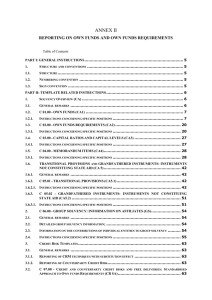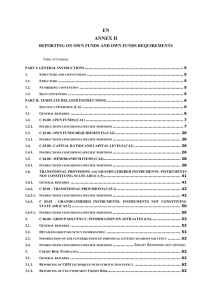Management Challenges around Enhanced Reporting
advertisement
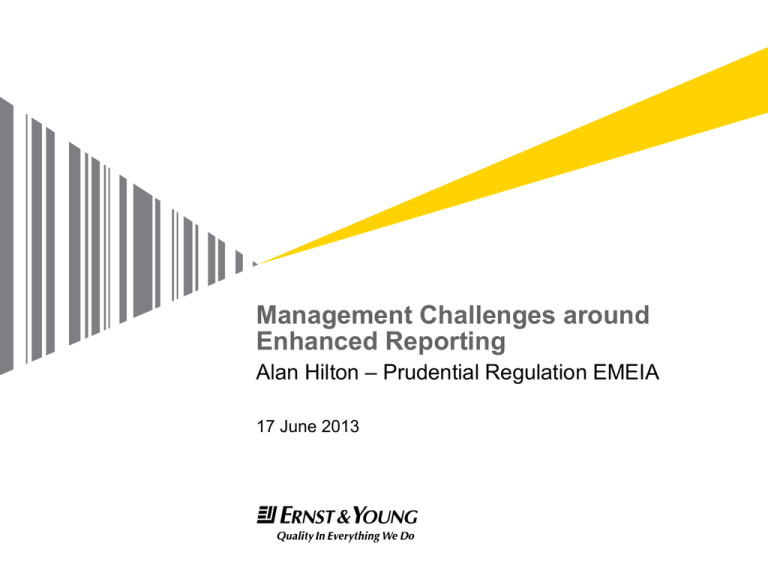
Management Challenges around Enhanced Reporting Alan Hilton – Prudential Regulation EMEIA 17 June 2013 Challenge 1: You wouldn’t start from here! Existing disclosures are not without issues... “Based on publicly available reports, the analysis shows considerable variation in average published mRWAs... ...the quality of disclosures was found to be insufficient to allow investors and other interested parties to assess how much of the variation reflects differing levels of actual risk and how much is a result of other factors.” Report on the Regulatory Consistency of Risk-weighted Assets for Market Risk. Basel Committee, January 2013 Page 2 Management challenges around enhanced reporting Challenge 2: CRD IV is clear – the management body is accountable for all aspects of reporting and disclosure Directive - Article 88 Governance Arrangements “...arrangements shall comply with the following principles: a. the management body must have the overall responsibility for the institution and approve and oversee the implementation of the institution's strategic objectives, risk strategy and internal governance; b. the management body must ensure the integrity of the accounting and financial reporting systems, including financial and operational controls and compliance with the law and relevant standards; c. the management body must oversee the process of disclosure and communications;” Regulation - Article 189 Corporate Governance “All material aspects of the rating and estimation processes shall be approved by the institution's management body or a designated committee thereof and senior management. These parties shall possess a general understanding of the rating systems of the institution and detailed comprehension of its associated management reports.” Page 3 Management challenges around enhanced reporting Challenge 3: CRD IV is here and represents a substantial change in the way the UK Industry is Regulated CRR/CRDIV changes to GENPRU/BIPRU Removed Rules 29% New or Divergent Rules 20% ► 20% of CRR/CRDIV rules are new or divergent from GENPRU/BIPRU ► 29% of GENPRU/BIPRU rules will be removed under CRR/CRDIV ► 6% of CRR/CRDIV rules contain provisions for the EBA to develop technical standards or allow the potential for a national discretion ► 45% of CRR/CRDIV rules are equivalent or consistent Further Guidance from the EBA ► Regulatory or Implementing Technical Standards due from the EBA in around 100 subject areas ► Many timetabled at or around CRD IV implementation date ► EBA guidance on specific aspects of disclosure (materiality, confidentiality and frequency) by December 2014 Areas for EBA to develop technical standards or potential national discretion 6% Equivalent or consistent rules (majority with minor wording differences) 45% Page 4 Management challenges around enhanced reporting Challenge 4: COREP/FINREP and increased public disclosures present significantly increased demands COREP Public disclosure ► High level of data granularity, volumes. 9,000 individual cells ► Increased slice and dice – currency, geography and legal entity ► ► Potential need to redesign business processes and architecture FINREP New requirements and mandatory requirements including: ► Diversity ► Remuneration ► Employee numbers by country & turnover by country Pillar 3 ► Requires reporting of 3,000 additional data items across 86 tables ► Much enhanced ► Pervasive impact across finance, product control, risk and treasury operations ► More granular ► More standardised ► Significant systems/process change ► ► Reporting needed 30 days after close – a challenge New items – capital buffers, credit adjustments and credit mitigation ► To include subsidiaries of material importance in local market ► Reconciliation of FINREP to Accounting Page 5 Management challenges around enhanced reporting Challenge 5: The bar is raised in terms of regulators’ expectations for data aggregation and risk reporting BCBS Principles for Effective Risk Data Aggregation & Risk Reporting ► Calls for more advanced analytics, aggregation and reporting capabilities ► Capital penalties explicit for non-compliance ► Monitoring/enforcement by SIG and local regulators (e.g., PRA for UK HQ G-SIBs) Governance & Infrastructure 1. Governance 2. Data Architecture & IT Infrastructure ► Risk Data Aggregation Capabilities 3. 4. 5. 6. Accuracy & Integrity Completeness Timeliness Adaptability Supervisory Review, Tools & Cooperation 7. Accuracy 8. Comprehensiveness 9. Clarity 10. Frequency 11. Distribution 12. Review 13. Remedial actions & supervisory measures 14. Home/Host cooperation Institutions designated as G-SIBs will need to meet the Principles within three years. Timeline for existing GSIBs is as follows: 2013 ► Risk Reporting Practices Self assessment and implementation plans shared with FSB Page 6 2013-2015 ► Standards Implementation Group (SIG) to track G-SIB implementation of BCBS Principles Management challenges around enhanced reporting 2016 ► Expected BCBS Compliance Responding to the Challenges: A checklist ► Systems and Controls ► ► ► Data quality ► ► ► Integrated Fin and Reg Reporting ► ► People ► Firms will need to revisit their approach to Systems & Controls under CRD IV Are controls comprehensive? Appropriate? Effective? Consistency Increased granularity of reporting will impact data quality tolerance & materiality thresholds Data quality of new data will come into scope Shorter timelines, more complex reporting, reduced adjustment options/capabilities Review, sign-off and submission processes The crossover between risk, finance and regulatory teams is increasing The target operating model for a firm’s COREP/FINREP solution should take into account these overlaps to design the most effective and efficient process to reduce systems and people costs, dependencies, etc. Reporting Teams will need to switch overnight to new requirements this will impact training & ability to adapt to change. Firms reliant on tactical solutions may have manual processes, requiring additional resourcing; this is not a one-off cost. ► ► ► ► Architecture ► ► ► Disclosure: external analysts ► ► ► Consistency of data across COREP, FINREP, Financial disclosures, Pillar 3, Bank of England, PRA & FCA will be difficult to manage. Reporting activities across Finance and Risk will be increasingly run in parallel For COREP & FINREP, the data volume to be reviewed and approved is dependent on the dimensions each firm has to complete: reporting units, geographic and currency etc. The traditional process of review and sign off needs to be considered in light of submission requirements. Timelines are short, quarterly releases in prospect, ongoing regulatory developments (leverage, liquidity, RRP). Many firms are pursuing a tactical route initially New impetus to review firmwide reporting & converge architecture, systems and processes Optimal format for disclosure unclear. Disclosure may impact on a firm’s focus on accuracy of reporting Impact of disclosure on a firm’s business needs to be assessed and managed Supporting qualitative disclosures Management challenges around enhanced reporting Thank you IMAGE EXPIRY: MM YY
